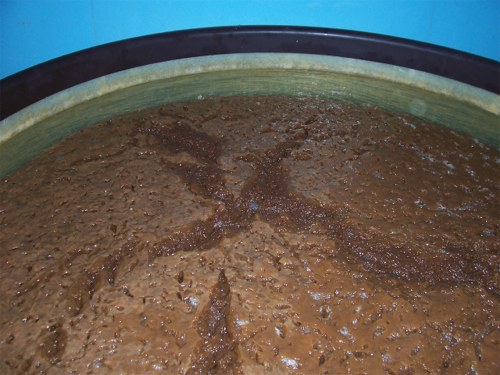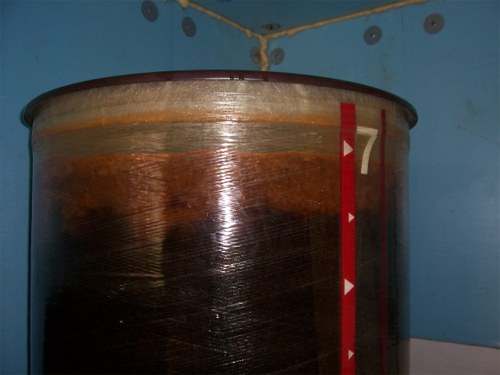4 / 5. Clarify and Transfer the Wort

Clarifying the wort is the most important stage, we call it : faire le "chapeau brun".
As soon as the wort comes out of the press and before fermenting, you must clear it as much as possible; that's done naturally and is called "clarifying" ( in French: faire le chapeau brun). The clarification is the beginning of a very slow fermentation, done at a low temperature (8-12°C max).
The wort coming out the press is very thick and carries a lot of glucid substances which coagulate. This coagulation goes to the top and makes a thick brown crust (chapeau brun); under this crust, the wort which was cloudy and thick becomes clear.

The crust acts like a filter and holds all the cloudy matter from the wort, lots of micro-organisms and a part of the nitrogen matter. During this time the heavier matter goes to the bottom. So a successful clarification: -
- eliminates the cloudy particles
- prevents the diseases by the elimination of most of the mouldiness and bacteria
- allows a slow fermentation with less nitrogen matter and less yeast (by 2 or 3 time less. It's the strong fermenting yeast: "saccharomyces cerevisiae uvarum")
- gives a better quality of the wort by the modifying of the yeast.
Points to remember -
- The wort must have good glucid substances, that means from clean apples in good maturity and not rotten.
- The temperature of the wort must be between 8-12°C. if the temperature is too high, the wort ferments too quickly, a white foam appears before the crust, the CO2 agitates the wort and the crust cannot form, the cider will never be clear; so you can THROW IT AWAY!!
- The wort must have enough calcium and enzymes, if not the crust will be poor or will not form at all.
- The bucket or cask must be filled in one day (maximum 2 days)
- To ensure you get a good crust, you can add with "esterase" enzyme (7-10 ml/100ltr) and calcium chloride (80gr max/100ltr) to the wort
- Allow a gap of 15cm at the top of the cask for the crust.
- Leave the cask to clarify during 5-8 days. when the crust starts to be broken up by the CO2, that means that it's fermenting well and time to transfer the clear wort in another cask, clean and disinfected.
- Check it every day, because if you wait to long for the transfer, the crust will be break and mixed in the wort by the CO2. The wort doesn't have lost more than 1-2 points.
- Transfer it without air ( like for the beer, put the siphon to the bottom of the cask) and put an airlock.
- These 2 steps (clarify and transfer) must be done in a short time (before 8 days) after the pressing.
- A successful clarify, following with a good transfer are the best ways of a good cider.
6 Fermentation
The clear wort is now fermenting (the sugar is transformed in alcohol and CO2 by the yeast)
The temperature of the cellar must be about about 10/12C. A slow fermentation (1 point / week) gives a better cider. This is done in a full cask without air and with an airlock.
If the cider is fermenting in a wooden barrel, the level of the cider will go down ( the liquid evaporate through the wood of the barrel), so it's necessary to fill the cask with cider or even good water. check the cask twice a month, or more, to see if you've to fill it; in French we call it : "ouillage" [English "ullage"].
- a second transfer is good to reduce the fermentation and take away the sediment. To do it, the weather must be calm and clear (high pressure) and do it in the same way that for the clarifying (low pressure unsaturates the cider and stirs the wort).
- don't transfer it if the density of the wort is between 1025 and 1035 because the cider will become "franboise" (cloudy and pungent aroma)
7. Bottling
The best way to keep the cider is to bottle it.
To bottle safely, the density mustn't have moved more than 2 points in 3 weeks.
- Between 1000 and 1005 : the cider will be dry
- Between 1010 and 1015 : the cider will be bitter (20-30 gr of sugar per litre)
- Between 1018 and 1020 : the cider will be sweet ( 36-40 gr of sugar/ litre)
- more than 1025 : the cider will be very sweet
If the cider is not very clear (too much nitrogen matter in it), the fermentation will keep going on and the cider will become very dry. so most cider-makers filter it.
Method to bottle the cider :
- weather must be good (high pressure )
- use clean bottles ("champenoise" bottle are better, because stronger)
- put the siphon to the bottom of the bottle (like for the beer)
- fill the bottle to the top without air; if you don't, the cider will spurt out like champagne!
Copyright Information: This site designed by Jim Dunleavy

